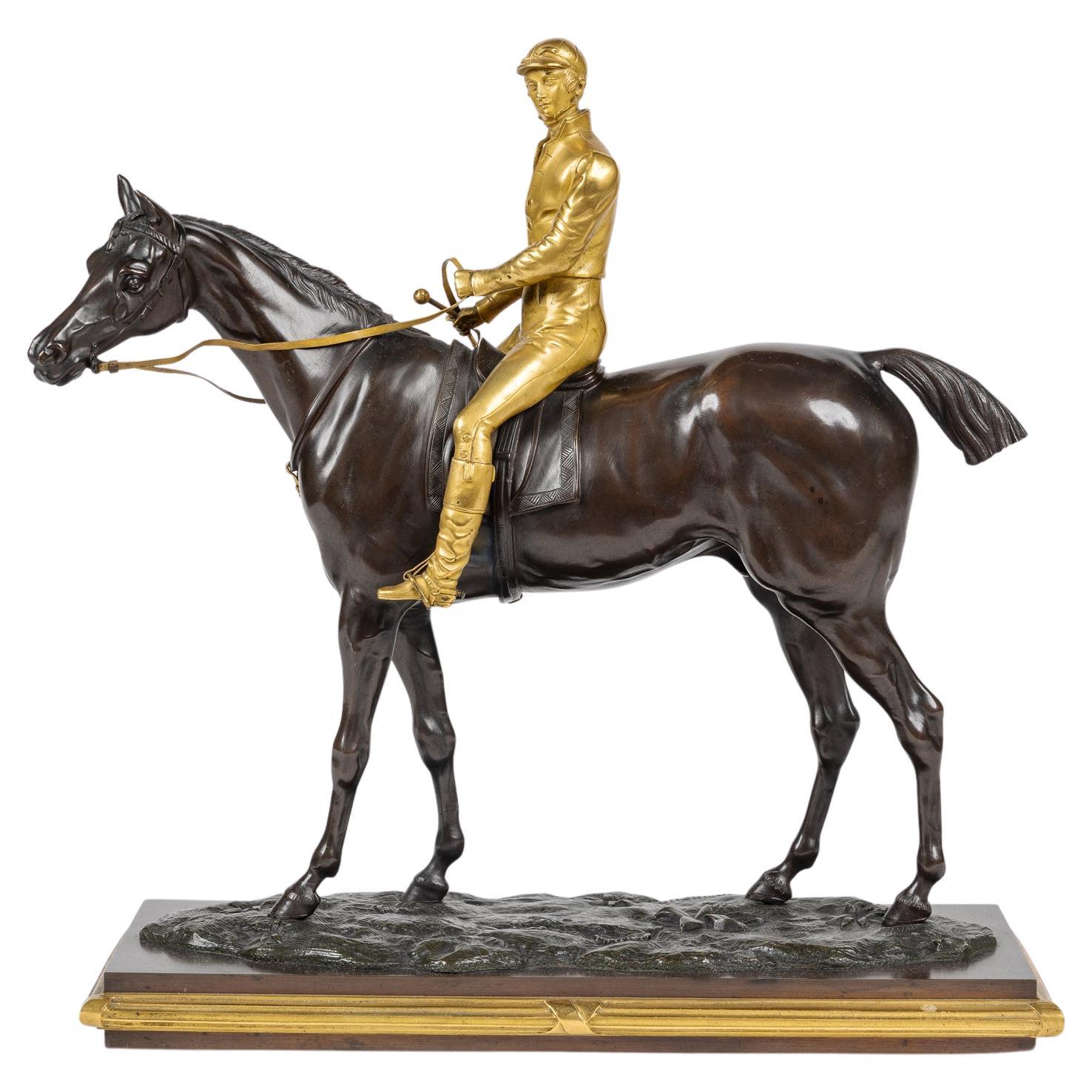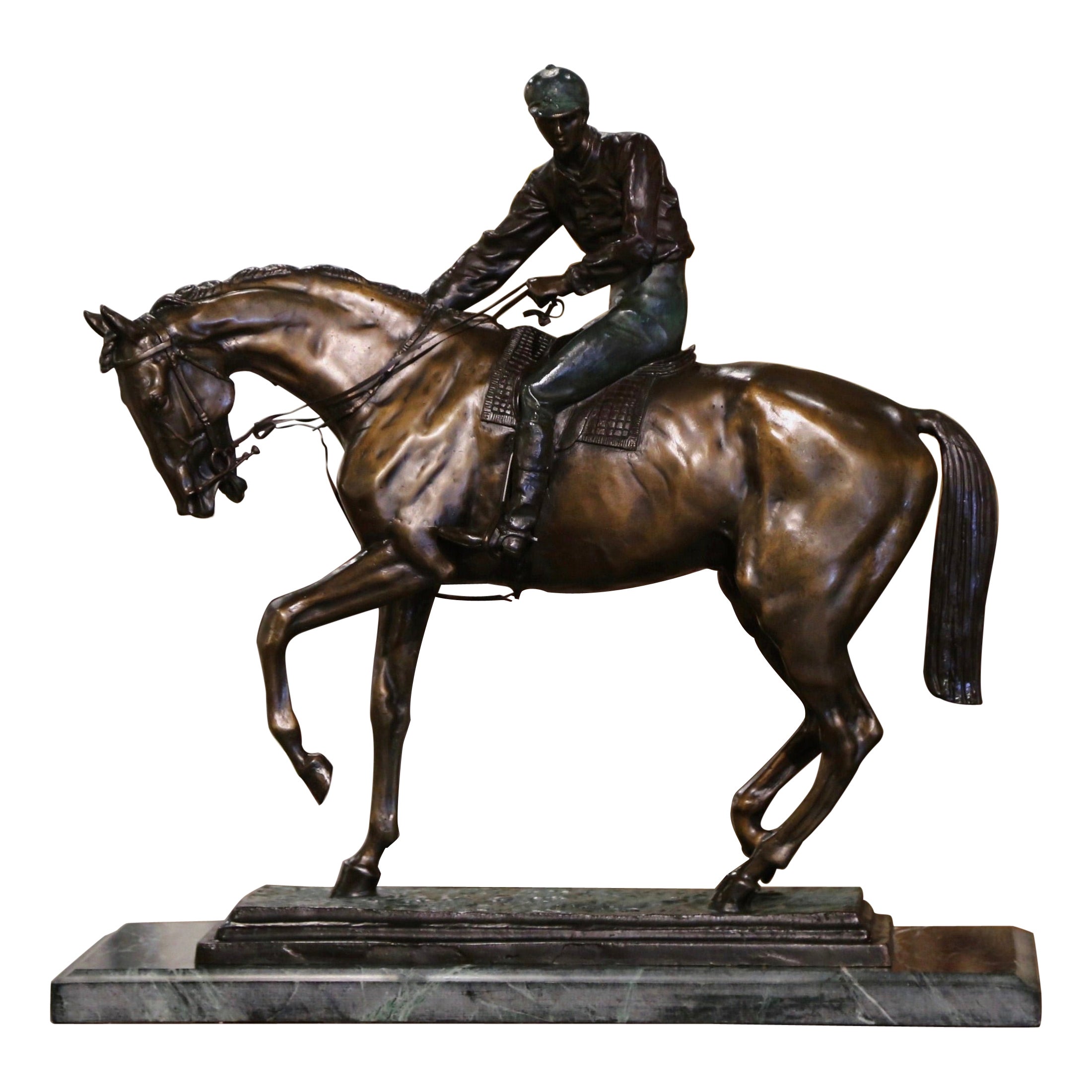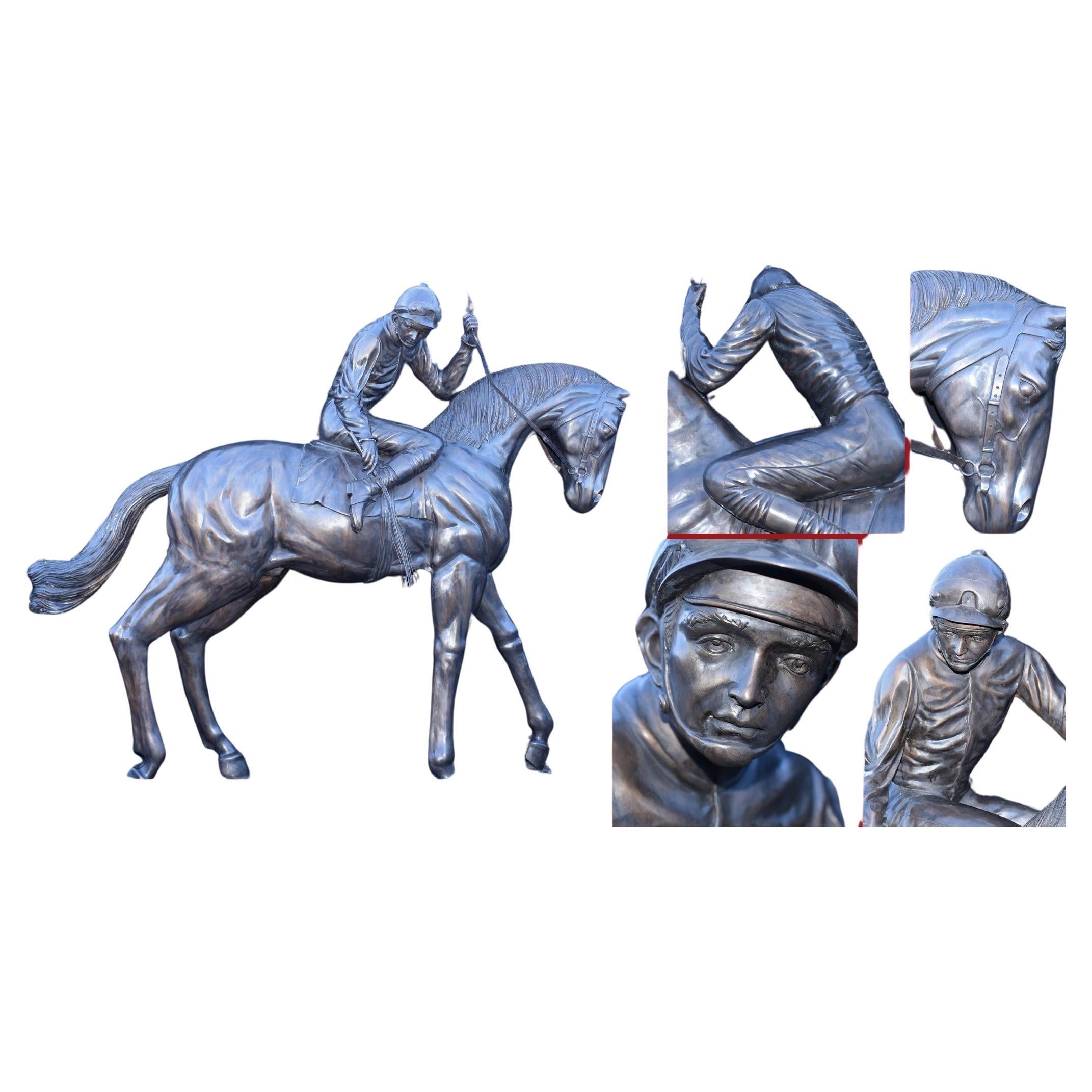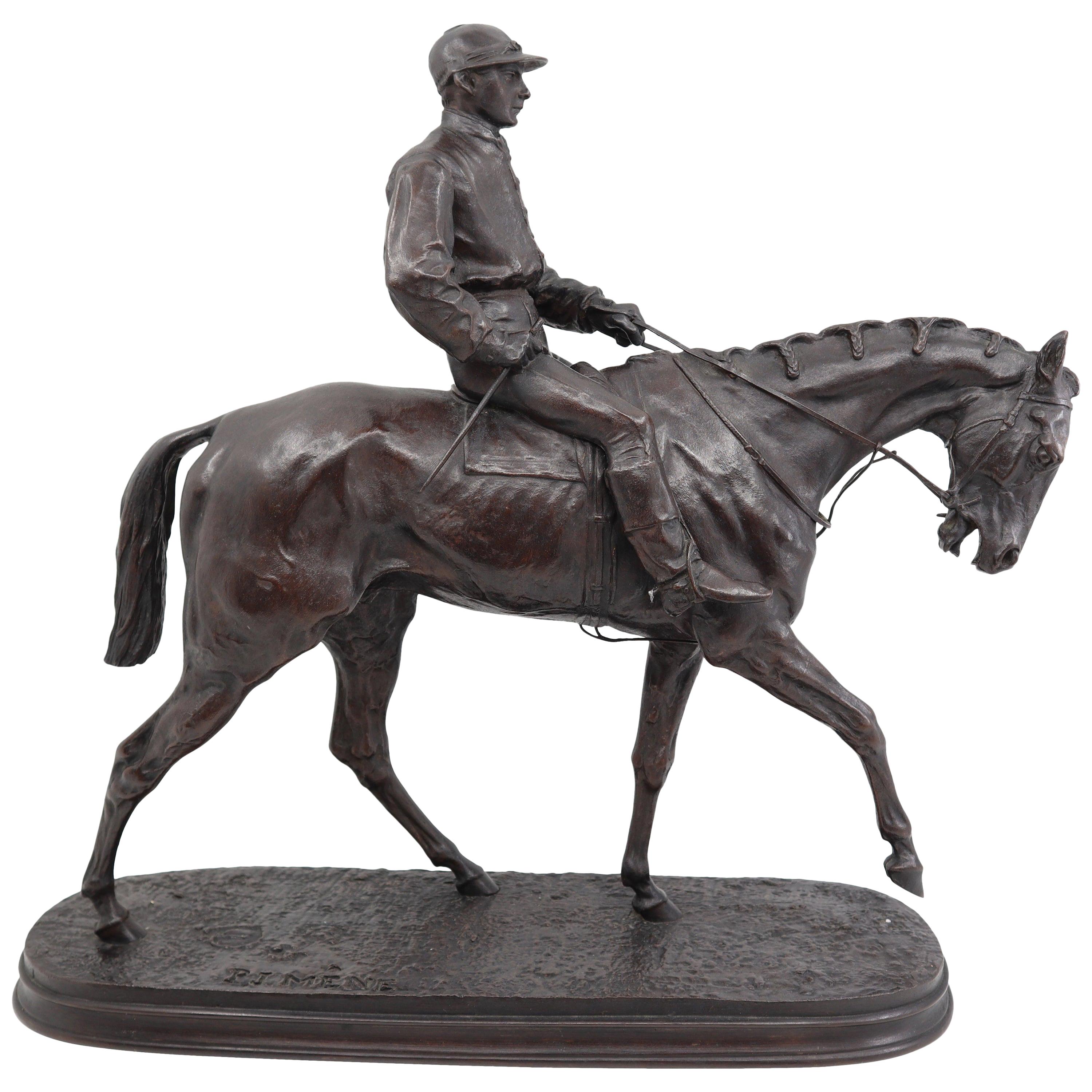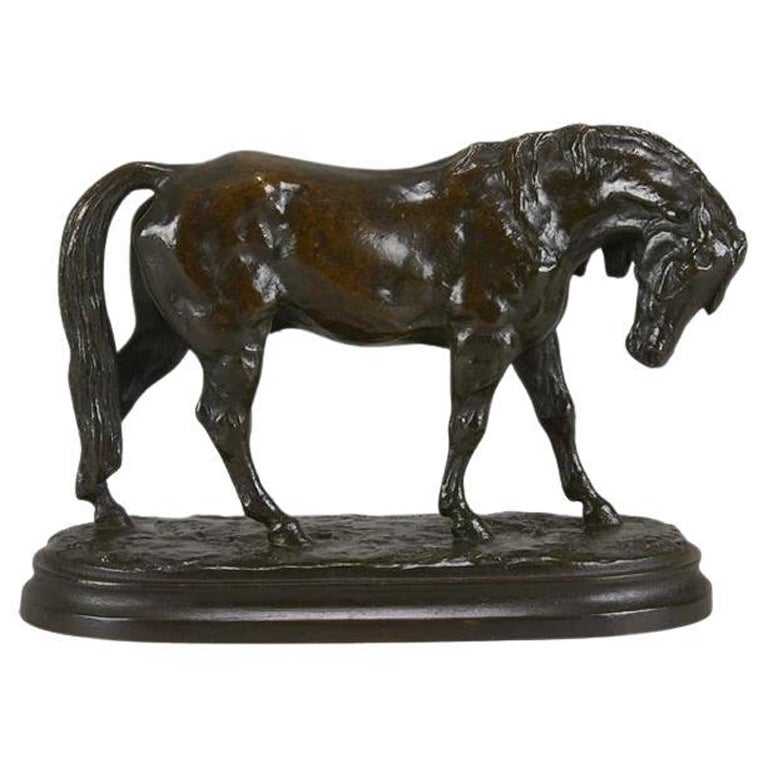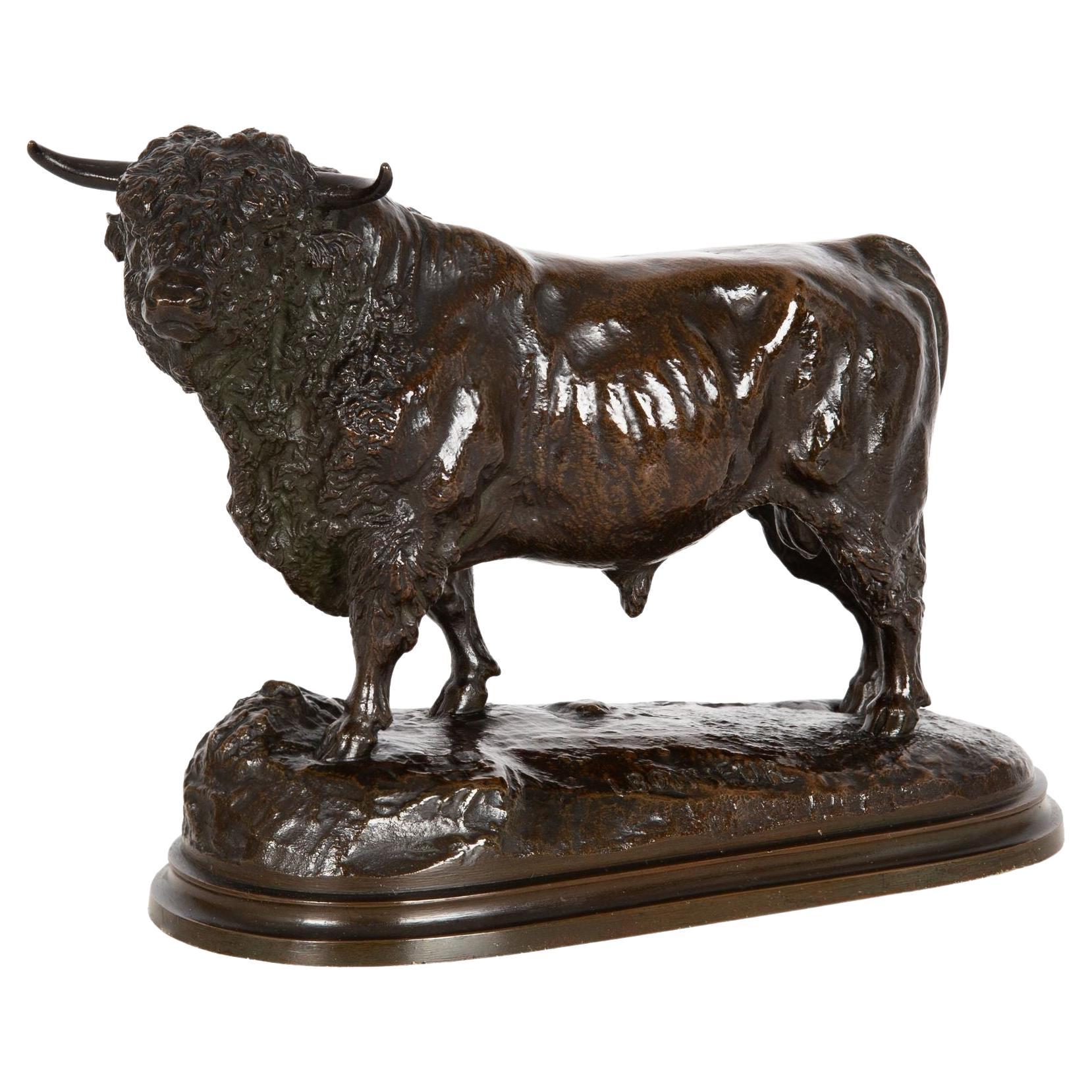Items Similar to ‘Le Grand Jockey ‘I by Sidore Jules Bonheur
Want more images or videos?
Request additional images or videos from the seller
‘Le Grand Jockey ‘I by Sidore Jules Bonheur
About the Item
Isidore Jules Bonheur (French, 1827-1901)
‘Le Grand Jockey ‘
Signed 'I Bonheur' and with foundry stamp PEYROL EDITEUR'.
Bronze, rich mid-brown patina.
The name Isidore-Jules Bonheur is synonymous with the great animalier school of sculptors of the late 19th century. Amongst Bonheur’s wide variety of animal sculptures exhibited at the Salon, there were a number of mounted equestrian models, including three designs of jockeys on horseback shown in 1864, 1879 and 1886. The most famous of these is Le Grand Jockey, of which the present cast is a rare, large, and fine example.
It shows a victorious jockey patting his horse on the neck in congratulation, perfectly chiselled especially with precision work for the veins, tendons and muscles, as well as the rider's jacket and the horse's mane. First exhibited at the 1879 Salon in bronze, under the title ‘Un Jockey’, it was displayed alongside another equestrian group, Un cavalier, époque de Louis XV (nos. 4817 and 4816 respectively). Exhibited again four years later at the Exposition Nationale des Beaux-Arts in 1883 and for the third time at the Universal Exhibition of 1889, where Bonheur received the prestigious Medaille d'Or. Le Grand Jockey was subsequently edited in four different sizes, the present cast being an example of the second largest.
Son of the painter Raymond Bonheur and brother of Rosa Bonheur, Isidore Bonheur was born in 1827 in Bordeaux and trained with his father. He exhibited in 1848 for the first time at the Salon des Artistes Français and entered the School of Fine Arts in Paris where he turned his attention to sculpture.
Bonheur had a close working relationship with his brother-in-law, the celebrated Parisian founder Hippolyte Peyrol, who was married to his sister Juliette (1830-1891). These close ties resulted in the production of exceptionally cast and finely chased bronzes, often identified, as here, by Peyrol's tiny cachet. Peyrol was a master caster and his foundry in Paris is rightly considered one of the finest of the period.
France, Circa 1890.
Literature
S. Lami, ‘Dictionnaire des sculpteurs de l’école française du XIXe siècle’, vol. 1, Paris, 1916, pp.127-130; J. Horswell, ‘Les Animaliers’, Woodbridge, 1971, p. 209; M. Forrest, Art Bronzes, Pennsylvania, 1988, p. 227.
M. Forrest, ‘Art Bronzes’, Pennsylvania, 1988, p. 227.
Pierre Kjellberg, ‘Les Bronzes du XIX e siècle’, Dictionnaire
des Sculpteurs, Paris 1987, l’Amateur Ed. Pages 102 et
103.
Isidore-Jules Bonheur (1827-1901) was the son of the painter Raymond Bonheur and younger brother of Rosa Bonheur, the famous sculptor. He was born in Bordeaux and studied painting, at first with his father and then with the Ecole des Beaux Arts in Paris, moving on to sculpture in 1848.
He made his debut at the Paris Salon in 1848 with a painting and plaster study of the same subject ‘African horseman attacked by a lioness’. From then onwards, Bonheur exhibited regularly at the Salon as well as other exhibitions, winning medals in 1865 and 1869 together with the prized Gold Medal at the Exposition Universelle of 1889.
He was awarded the Legion d’Honneur in 1895.
Most of Bonheur’s casts were by his uncle by marriage, Hippolyte Peyrol, whose tiny foundry mark is often very difficult to find.
Bonheur’s studies range from farm animals, bears and tigers in a very naturalistic vein to equestrian groups. Although noted primarily for his small groups he did complete two large scale commissions, one to his sister Rosa, at Fontainbleau and the other, two stone lions at the steps of the Royal Palais de Justice, Paris. Bonheur became part of the group of animal sculptors of the late nineteenth century known as ‘Les Animaliers’
Working in a realistic manner, Bonheur was an acute observer of nature - his animals were not ‘humanised’ but modelled to catch a pose characteristic of the particular species. He achieved this particularly well with his sculptures of horses, which, usually more relaxed than spirited, are among his most successful works.
Literature
Jane Horswell, Bronze Sculptures of ‘Les Animaliers’ , p201
Pierre Kjellberg, Les Bronzes du XIX Siècle, p101.
- Creator:Isidore Jules Bonheur (Sculptor)
- Dimensions:Height: 24.41 in (62 cm)Width: 29.53 in (75 cm)Depth: 6.3 in (16 cm)
- Materials and Techniques:Bronze,Patinated
- Place of Origin:
- Period:
- Date of Manufacture:circa 1890
- Condition:Wear consistent with age and use.
- Seller Location:Brighton, GB
- Reference Number:
About the Seller
5.0
Recognized Seller
These prestigious sellers are industry leaders and represent the highest echelon for item quality and design.
Established in 1964
1stDibs seller since 2014
49 sales on 1stDibs
Typical response time: 1 hour
Associations
The British Antique Dealers' AssociationLAPADA - The Association of Arts & Antiques Dealers
- ShippingRetrieving quote...Ships From: Brighton, United Kingdom
- Return PolicyA return for this item may be initiated within 7 days of delivery.
More From This SellerView All
- Pair of Bronze Models of a Standing Bull and a Running Cow, circa 1890By Isidore Jules Bonheur, Francois Auguste Hippolyte Peyrol 1Located in Brighton, West SussexA pair of large and finely patinated bronze models of a standing bull and a running cow after models by Isidor-Jules Bonheur, Cast on a Naturalistic Base. French, circa 1890. Signed 'I BONHEUR' and stamped 'PEYROL EDITEUR'. Bonheur was a regular exhibitor at the Paris Salon and his naturalistic depiction of farm animals, including cattle, was one of his most popular subjects. The bronze was cast by his brother-in-law, Hippolyte Peyrol, who ran one of the most successful art foundries in Paris at this time. Isidore-Jules Bonheur (1827-1901) was the son of the painter Raymond Bonheur and younger brother of Rosa Bonheur, the famous sculptor. He was born in Bordeaux and studied painting, at first with his father and then with the Ecole des Beaux Arts in Paris, moving on to sculpture in 1848. He made his debut at the Paris Salon in 1848 with a painting and plaster study of the same subject ‘African horseman attacked by a lioness’. From then onwards, Bonheur exhibited regularly at the Salon as well as other exhibitions, winning medals in 1865 and 1869 together with the prized Gold Medal at the Exposition Universelle of 1889. He was awarded the Legion d’Honneur in 1895. Most of Bonheur’s casts were by his uncle by marriage, Hippolyte Peyrol, whose tiny foundry mark is often very difficult to find. Bonheur’s studies range from farm animals, bears and tigers in a very naturalistic vein to equestrian groups. Although noted primarily for his small groups he did complete two large scale commissions, one to his sister Rosa, at Fontainbleau and the other, two stone lions at the steps of the Royal...Category
Antique Late 19th Century French Animal Sculptures
MaterialsBronze
- 'Grand Nu Aux Feuillages', a Fine Patinated Bronzed Figural Group, circa 1900By Alois MayerLocated in Brighton, West Sussex'Grand Nu Aux Feuillages', a fine patinated bronzed figural group by Alois Mayer. German, circa 1900. Signed 'A. Mayer'. Alois Mayer (1855-1936) Was a German Sculptor who...Category
Antique Late 19th Century German Figurative Sculptures
MaterialsBronze, Iron
- 'Le Puits Qui Parle' an Exhibition Bronze, Paul Eugène Mengin French, circa 1900By Paul Eugène Mengin 1, Susse FreresLocated in Brighton, West Sussex'Le Puits Qui Parle' (The Speaking Well) - An Important Exhibition Bronze Group, by Paul Eugène Mengin. Signed to the cast 'P MENGIN', and inscri...Category
Early 20th Century French Figurative Sculptures
MaterialsBronze
- 'The Soldier of Marathon' Bronze after a Model by Cortot Cast by BarbedienneBy Jean Pierre Cortot, Ferdinand BarbedienneLocated in Brighton, West Sussex'The Soldier of Marathon' - A large patinated bronze group after a model by Jean-Pierre Cortot, Cast by Ferdinand Barbedienne. Jean-Pierre Cort...Category
Antique Late 19th Century French Figurative Sculptures
MaterialsBronze
- 'The Temptation' by Eugene-Victor CherrierBy Eugène-Victor CherrierLocated in Brighton, West Sussex'The Temptation' by Eugene-Victor Cherrier. A fine patinated bronze ewer modeled in high relief depicting Adam and Eve in the Garden of Eden. Sig...Category
Antique Early 1900s French Art Nouveau Figurative Sculptures
MaterialsBronze
- ‘Les Grands Faunes’, a Pair of Candelabra after François Rémond, circa 1880By François RémondLocated in Brighton, West Sussex‘Les Grands Faunes’, a large and very finely cast pair of gilt bronze and patinated bronze figural candelabra on green granite marble bases, after a model by François Rémond...Category
Antique Late 19th Century French Louis XV Candelabras
MaterialsBronze
You May Also Like
- Late 19th Century French Bronze Sculpture "Le Grand Jockey" Signed I. BonheurBy Isidore Jules BonheurLocated in Dallas, TXDecorate an office or study with this large antique bronze sculpture. Created in France circa 1880, and signed by French sculptor Isidore Bonheur, the sculpture is set on a green mar...Category
Antique Late 19th Century French Animal Sculptures
MaterialsMarble, Bronze
- Isidore-Jules Bonheur, A Rare Gilt and Patinated Bronze Jockey on A HorseBy Isidore Jules BonheurLocated in New York, NYIsidore-Jules Bonheur (French, 1827–1901) A Rare Gilt and Patinated Bronze Jockey on A Horse, circa 1875. Introducing a truly exceptional and highly s...Category
Antique 19th Century French Sporting Art Animal Sculptures
MaterialsBronze
- Lifesize French Bronze Horse and Jockey Statue by BonheurLocated in Potters Bar, GBGorgeous lifesize bronze horse and jockey statue originally by French artist Isidore Bonheur. This is 80 inches high - 203 CM. The horse and jockey is perhaps one of the most popula...Category
Vintage 1980s Figurative Sculptures
MaterialsBronze
- French Bronze Jockey on Horse by Pierre Jules MêneBy Pierre Jules MêneLocated in Lantau, HKA self-taught artist, Piere-Jules Mêne (1810-1879) dedicated his entire career to making bronze statues, which were met with great success among both French and international clients...Category
Antique 19th Century French Animal Sculptures
MaterialsBronze
- French Animalier Bronze Study Entitled 'Cheval Debout' by Isidore BonheurBy Isidore Jules BonheurLocated in London, GBFabulous late 19th Century French Animalier bronze study of a standing horse with wonderful rich dark brown lightly rubbed to mid/golden brown patina and excellent crisp surface detail, raised on a stepped integral base, signed I Bonheur ADDITIONAL INFORMATION Height: 13 cm Length: 19 cm Condition: Excellent Original Condition Circa: 1870 Materials: Bronze Book Ref Animals in Bronze by Christopher Payne Kjellberg Page no. 177 SKU: 8526 DESCRIPTION Isidore Bonheur Bonheur Cheval– Isidore Bonheur (1827 ~ 1901) was born on May 15th 1827 in Bordeaux, France, and died in Paris in 1901. He was an important Animalier sculptor, the brother of Rosa Bonheur, and brother-in-law to Hippolyte Peyrol the founder. The Bonheurs were a well known family of painters, sculptors and artists. Isidore studied painting under the tutelage of his father at a very early age. He moved on to sculpture in 1848 with his first Salon entry of a plaster study of An African Horseman attacked by a lion. Isidore Bonheur continued exhibiting his sculpture throughout the years, both at the Salon in Paris as well as the Royal Academy in London. He won medals at the Salon in 1865 and 1869, and won the Gold Medal at the Paris Exposition Universelle of 1889. Bonheur was awarded the Legion of Honneur in 1895. Isidore Bonheur’s bronzes range from domestic cattle and sheep, which he excelled at, to wild bears and lions as well as equestrian and hunting groups, all done in a very natural and realistic manner. His Le Grand Jockey...Category
Antique Late 19th Century French Victorian Animal Sculptures
MaterialsBronze
- French, Antique Bronze Sculpture of Aberdeen Angus Bull by Isidore BonheurBy Isidore Jules BonheurLocated in Shippensburg, PAISIDORE JULES BONHEUR French, 1827-1901 Taureau Aberdeen-Angus" (Standing Aberdeen-Angus Bull) Patinated sand-cast bronze Signed to base "I. BONHEUR" Item # 211HDB17Z An exquisite and very rare casting of an Aberdeen-Angus bull, an unusual and distinctive breed of cattle from Scotland, this sculpture by Isidore Jules Bonheur is almost without a doubt cast by the foundry of his brother-in-law Hippolyte Peyrol and a rather early model as well in light of the distinctive construction method. In her text on the selection of 46 animal bronzes in the collection of the Georgia Museum of Art, Eleanor Luciano notes regarding this model that "Bonheur is never recorded to have been to Scotland, where he would have seen this unusual breed. Rosa Bonheur painted in Scotland, and its seems likely that Isidore would have drawn the idea for this bull either from one of her sketches or from an agricultural show in France. The animal's rich mane and strong modeling make this one of the most successful." Notable is the very fine surface patination which exhibits a glassy finish with a complex range of colors presenting in the body of the bull, overall being medium brown but augmented with an underlying reddish hue against auburn highlights. The base is signed "I. BONHEUR" in the typical manner. Museum Collections: * National Gallery of Art, Washington DC, acc. no. 2006.128.3 * Georgia Museum of Art, University of Georgia...Category
Antique 19th Century French Romantic Animal Sculptures
MaterialsBronze
